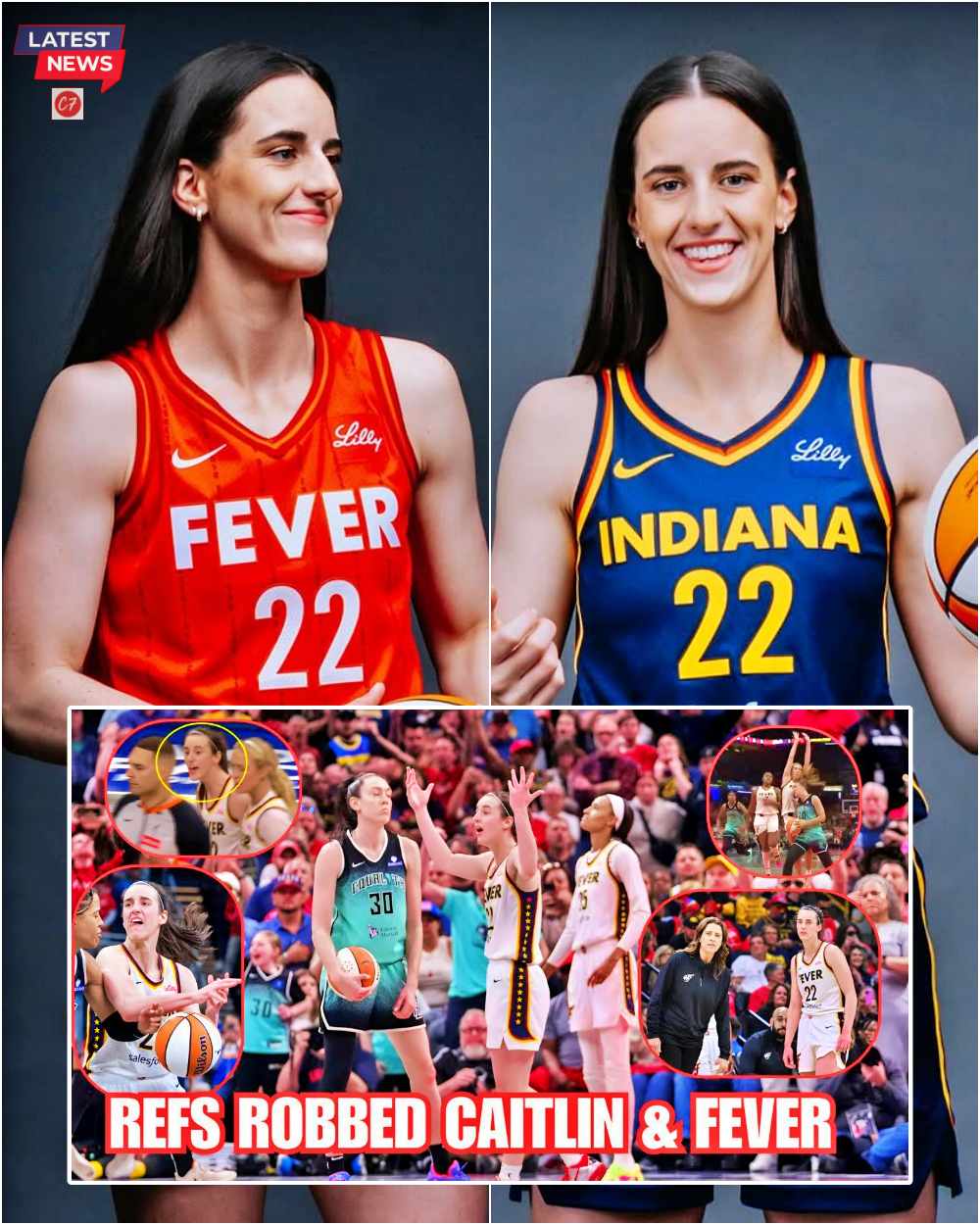
2.9 seconds left.
Caitlin Clark stepped into space, squared her shoulders, and rose to shoot.
The defender’s arm came down hard—across her wrist, into her shooting side.
The ball didn’t release clean.
And neither did the whistle.
Play on.
The crowd in Indianapolis erupted—not in celebration, but in disbelief.
One fan courtside threw their hands in the air before the ball even hit the floor.
The buzzer sounded.
Liberty 90, Fever 88.
But what stayed wasn’t the score.
It was the silence.
This wasn’t just a missed shot.
It wasn’t just a no-call.
It was the moment fans across the country began asking a different question:
Is Caitlin Clark getting the same whistle as everyone else?
The Game That Sparked It All
Indiana vs. New York.
A back-and-forth thriller.
Both teams trading punches, momentum swinging like a pendulum.
Liberty had their run: 18–1 in the second, 16–2 in the fourth.
But the Fever answered.
Down 15? No problem.
They roared back with a 27–9 surge in the third.
By the time the fourth opened, they were up 8.
It looked like a statement win in the making.
Then came the whistles.
Lexie Hull called for a touch foul on Sabrina Ionescu.
Dana Evans hit hard in transition—no whistle.
Caitlin Clark? Clamped on the game’s final possession.
And no call.
The Discrepancy That Can’t Be Ignored
Free throw attempts:
New York: 32
Indiana: 15
That’s not just imbalance.
That’s a pattern.
And it wasn’t the first time.
Stephanie White, head coach of the Fever, didn’t mince words after the game:
“I think it’s pretty egregious what’s been happening to us the last few games.
A minus-31 free throw discrepancy? I might understand that if we were just chucking threes. But we’re attacking the rim.”
It’s a stat.
But it’s also a signal.
Clark has drawn contact in every game this season—drives, step-backs, handoffs.
But the whistles?
Inconsistent at best.
Absent at worst.
One Moment. One Look.
Clark didn’t argue after the no-call.
She didn’t gesture to the ref.
Didn’t throw a towel.
Didn’t even speak.
She walked off the court slowly.
Paused.
Turned to glance at the jumbotron—just in time to see the replay of her final drive.
She blinked.
Then kept walking.
No words.
But the image spoke.
Stephanie White Steps In
Postgame, White’s voice didn’t shake.
But her message did.
“It’s not just tonight.
We’re not getting consistency.
And the disrespect for our team has been… unbelievable.”
She didn’t say “bias.”
She didn’t say “targeted.”
She didn’t have to.
Her tone carried everything the box score didn’t.
Inside the Locker Room
Reporters were kept at a distance.
Clark declined to speak.
Aaliyah Boston sat with ice wrapped around her knees, nodding along as her coach defended them.
A staffer who witnessed the moment described it like this:
“Caitlin didn’t look upset. She looked like someone who’d been told, again, that she just had to deal with it.”
The Numbers Behind the Noise
Through four games, the Fever have attempted fewer free throws than any other team in the league.
Clark?
She’s averaging nearly 7 drives per game—yet has shot single-digit free throws in all but one outing.
Statistically, she’s among the lowest foul-drawing high-usage players in the WNBA.
And when you watch the footage, it’s not hard to see why that’s raising eyebrows.
Two Possessions from Perfection
The Fever are now 2–2.
Their last three games?
Decided by a combined 8 points.
They’re two possessions away from being 4–0.
And yet the tone is frustration—not celebration.
That’s what this feels like for Indiana right now.
They’ve been good.
They’ve been close.
They’ve competed.
But something’s missing.
And that something is justice.
The Clark Conundrum
Caitlin Clark is the WNBA’s biggest draw.
The numbers don’t lie:
TV ratings: up 54%
Arena attendance: doubled in several cities
Jersey sales: league-best
Social engagement: unmatched
So why does it feel like she’s the most disrespected player on the floor?
Not by fans.
Not by opponents.
But by the people in stripes.
A Veteran Analyst Said It Best:
“When your league’s most visible star doesn’t get the benefit of the doubt—it doesn’t just hurt her.
It hurts your product.”
Reactions Across the League
On X, the clip of the no-call drew millions of views.
#FreeCaitlin trended.
#Robbed was used in over 100,000 posts.
Even rival WNBA fan pages shared the footage—with captions like:
“You don’t have to like her.
But if that’s not a foul, what is?”
The Moment That’s Bigger Than a Call
Let’s be clear:
This isn’t just about one game.
The frustration has been building.
Clark’s shot has been off.
Her turnovers are high.
She’s adjusting to the speed, the contact, the expectations.
But through it all—she’s stayed composed.
She hasn’t lashed out.
Hasn’t blamed refs.
Hasn’t played the victim.
She just plays.
But now, the silence is costing her.
And people are starting to notice.
Final Freeze
A photographer caught a now-iconic image as Clark left the court.
She’s walking past a group of fans.
One little girl holds a homemade sign:
“Caitlin, You Deserve Better.”
Clark doesn’t look up.
She just presses a hand to her chest.
Nods.
And keeps walking.
The crowd doesn’t roar.
It watches.
Quietly.
Because something broke tonight.
Not just a two-game win streak.
But the belief that if you perform, you’ll be protected.
They didn’t just lose to the Liberty.
They lost faith in the whistle.
And now, the whole league is listening.
DISCLAIMER:
This article is a longform feature built upon real game footage, press conference quotes, and public reactions surrounding recent WNBA matchups involving Caitlin Clark and the Indiana Fever. All statistics, postgame comments, and reported moments were sourced from publicly available broadcasts and media sessions.
Select descriptions, reflections, and composite scenes have been expanded or stylized to capture the emotional tone, narrative arc, and broader conversations currently circulating within the sports community. These interpretations are consistent with best practices in editorial storytelling and commentary journalism.
No part of this article should be interpreted as a legal accusation or conclusive judgment of individual or institutional intent. Rather, the piece aims to reflect the lived experience of fans, players, and observers navigating the realities of elite competition and public scrutiny.
Readers are encouraged to approach this content as an immersive account of reactions and implications following high-stakes sporting events—not as a formal review of officiating or institutional conduct.




